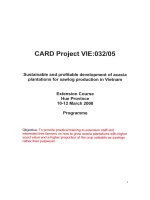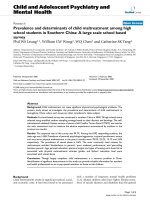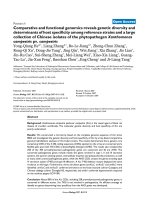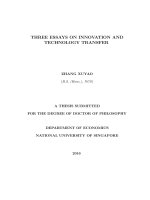Three essays on antecedents and determinants of entrepreneurial intention among business students in viet nam toward an integrated theory
Bạn đang xem bản rút gọn của tài liệu. Xem và tải ngay bản đầy đủ của tài liệu tại đây (2.93 MB, 151 trang )
ECOLE DOCTORALE DE MANAGEMENT PANTHÉON-SORBONNE
ESCP Europe
Ecole Doctorale de Management Panthéon-Sorbonne
ED 559
THREE ESSAYS ON ANTECEDENTS AND DETERMINANTS OF ENTREPRENEURIAL INTENTION
AMONG BUSINESS STUDENTS IN VIETNAM: TOWARD AN INTEGRATED THEORY
THESE
En vue de l’obtention du
DOCTORAT ÈS SCIENCES DE GESTION
Par
Cuong NGUYEN
Soutenance publique le 19 juin 2019
JURY
Directeur de Recherche :
Mme Jacqueline FENDT
Professeure
ESCP Europe
Rapporteurs :
Mme Lan Huong BUI THI
Professeure
Centre Franco Vietnamien de Gestion
Mme Nada ENDRISSAT
Professeure
Bern University of Applied Sciences
Suffragants :
M. Jean-Pierre HELFER
Professeur
Université Paris 1 Panthéon-Sorbonne, IAE de Paris
M. Sébastien POINT
Professeur
Université de Strasbourg
ECOLE DOCTORALE DE MANAGEMENT PANTHÉON-SORBONNE
L’Université n’entend donner aucune approbation ou improbation aux opinions émises dans les thèses. Ces
opinions doivent être considérées comme propres à leurs auteurs.
ECOLE DOCTORALE DE MANAGEMENT PANTHÉON-SORBONNE
4
ECOLE DOCTORALE DE MANAGEMENT PANTHÉON-SORBONNE
Acknowledgements
Firstly, I would like to express my sincere gratitude to Prof. Jacqueline FENDT for her continuous
support of my Ph.D. study, for her patience, kindness, motivation, and immense knowledge. Her
guidance helped me in all the time of my research and writing of this thesis. Honestly, I could not
have imagined that I can finish my Ph.D. research without her enormous support. Besides my
advisor, I would like to thank my rapporteurs : Prof. Lan Huong BUI THI and Prof. Nada
ENDRISSAT, for their insightful comments and encouragement, but also for the questions which
incented me to widen my research from various perspectives.
My sincere thanks also go to the Embassy of France in Viet Nam for granting me the Excellence
Scholarship from 2015 to 2018, so I can go to Paris to do my Ph.D. research. I would like to thank
the ESCP Europe Paris Campus for giving me excellent access to the laboratory and research
facilities. Without the school’s precious supports, it would not be possible for me to finish my
research. Especially, I would like to send my heartfelt thanks to the Doctoral Programme Manager
of ESCP Paris Campus. Christine Rocque, ESCP’s staff and all my fellow labmates supporting me
from the beginning of my research.
Last but not least, I would like to thank my beloved family : my parents and my brother and sister
for supporting me spiritually and financially during the past four years.
5
ECOLE DOCTORALE DE MANAGEMENT PANTHÉON-SORBONNE
Acknowledgments
Table of Contents
List of Figures
List of Tables
5
7-9
10
11
Table of Contents
INTRODUCTION................................................................................................................ 13
1. The Strategic Importance of Entrepreneurship............................................................ 15
2. The Vietnamese Entrepreneurial Context ..................................................................... 17
2.1 The contribution of entrepreneurship to Vietnamese economy ................................. 17
2.2 Entrepreneurial Perceptions in Vietnam in 2015-2016 .............................................. 19
2.3 Vietnamese young people and entrepreneurial opportunities and potential for business
start-ups ............................................................................................................................ 24
2.4 Social perception about entrepreneurs in 2015 .......................................................... 26
3. The Importance of Entrepreneurial Intention Research in Vietnam ......................... 28
4. Theoretical Foundation ................................................................................................... 30
4.1 The construct of Entrepreneurship and Entrepreneurial Intention ............................. 33
4.2 Entrepreneurial Intention Research Models ............................................................... 34
4.2.1 Demographic Approach .................................................................................. 34
4.2.2 Environmental Influences Approach. ............................................................. 40
4.2.3 Shapero’s Entrepreneurial Event .................................................................... 41
4.2.4 Ajzen’s Theory of Planned Behaviour ........................................................... 43
4.3 Entrepreneurial researches in Vietnamese context. .................................................. 46
5. Research Question and Research Methodology ............................................................ 49
7
ECOLE DOCTORALE DE MANAGEMENT PANTHÉON-SORBONNE
PART I-A. Entrepreneurial Intention In Vietnam: Same As Everywhere?
Abstract .................................................................................................................................. 67
1. Introduction ........................................................................................................................ 68
2. Literature Review and Hypothesis Development .............................................................. 69
3. Research Methodology ...................................................................................................... 74
4. Data Analysis ..................................................................................................................... 78
5. Conclusion and Discussion ................................................................................................ 86
References .............................................................................................................................. 89
PART I-B. Entrepreneurial Intention of International Business Students in Viet Nam:
A survey of the country joining The Trans-Pacific Partnership
Abstract .................................................................................................................................. 93
Introduction ............................................................................................................................ 94
Literature Review and The Hypothesis.................................................................................. 95
Research Methodology ........................................................................................................ 101
Results .................................................................................................................................. 103
Conclusion ........................................................................................................................... 109
Discussion ......................................................................................................... 109
Implications ....................................................................................................... 110
Limitations and Further Research ..................................................................... 111
References ............................................................................................................................ 115
PART II. Demographic Factors, Family Background and Prior Self-Employment on
Entrepreneurial Intention - Vietnamese Business Students Are Different: Why?
Abstract ................................................................................................................................ 121
Background .......................................................................................................................... 122
Research Framework ........................................................................................................... 124
Entrepreneurial intention................................................................................... 124
Gender ............................................................................................................... 126
Age .................................................................................................................... 127
8
ECOLE DOCTORALE DE MANAGEMENT PANTHÉON-SORBONNE
Education level .................................................................................................. 127
Prior exposure to self-employment ................................................................... 128
Parent’s employment and family background .................................................. 129
Research Methodology ........................................................................................................ 131
Data collection process ..................................................................................... 132
Research Instruments ........................................................................................ 132
Results and Discussion ........................................................................................................ 133
Conclusion and Further Research ........................................................................................ 140
References ............................................................................................................................ 145
PART III. A Qualitative Study of Factors That Influences Entrepreneurial Intentions
among Business Students and Small Business Owners.
Abstract ................................................................................................................................ 151
Introduction .......................................................................................................................... 152
Literature Review................................................................................................................. 153
Entrepreneurial intention................................................................................... 153
The Theory of Planned Behaviour Model......................................................... 154
Shapero’s Entrepreneurial Event Model ........................................................... 156
Qualitative Research Methods and Entrepreneurial Intention………………...157
Research Methodology ........................................................................................................ 158
Results ................................................................................................................................. 159
Discussion and Conclusion .................................................................................................. 164
References ............................................................................................................................ 166
CONCLUSION .................................................................................................................. 169
Implications for theory………………………………………………………….169
Implications for entrepreneurial policymakers in emerging market……...…….177
Implications for educational institution…………………………………………181
Limitations and Further research………………………………………………..183
REFERENCES ........................................................................................................... ……187
9
ECOLE DOCTORALE DE MANAGEMENT PANTHÉON-SORBONNE
Table of figures
Figure 1-The number of newly established firms and GDP Growth Rate of Viet Nam in 2013 –2018
(GSO, 2019) ........................................................................................................................................ 18
Figure 2-Perceived Opportunities in Vietnam in 2015. Source: The Global Adult Population Survey
(APS, 2015) ........................................................................................................................................ 20
Figure 3-Perceived Capabilities in Vietnam in 2015. Source: The Global Adult Population Survey
(APS, 2015) ........................................................................................................................................ 21
Figure 4-Fear of Business Failure in Vietnam in 2015. Source: The Global Adult Population Survey
(APS, 2015) ........................................................................................................................................ 22
Figure 5-Entrepreneurial Intention in Vietnam in 2015. Source: The Global Adult Population Survey
(APS, 2015) ........................................................................................................................................ 24
Figure 6-Entrepreneurial opportunities and potential for business start-ups by age group in Vietnam
in 2015. Source: The Global Adult Population Survey (APS, 2015 ................................................... 25
Figure 7-Social perception about entrepreneurial in Vietnam in 2015. Source: The Global Adult
Population Survey (APS, 2015). ........................................................................................................ 27
Figure 8- Shapero’s Entrepreneurial Event-source: (Shapero, 1975) ................................................ 42
Figure 9- Krueger and Shapero’s Entrepreneurial Event-source: (N. F. J. a. B. Krueger, D.V, 1994;
Shapero, 1975) ................................................................................................................................... 43
Figure 10-Ajzen’s Theory of Planned Behviour-source: (Ajzen, 1991) ............................................ 44
Figure 11- Ajzen’s Theory of Planned Behaviour (1991).................................................................. 50
Figure 12-Krueger and Shapero’s Entrepreneurial Event (N. F. J. a. B. Krueger, D.V, 1994; Shapero,
1975). ................................................................................................................................................. 72
Figure 13: Ajzen’s Theory of Planned Behviour (Ajzen, 1991) ....................................................... 72
Figure 14-Multiple Regression Analysis Results of The Theory of Planned Behaviour ................... 86
Figure 15-Krueger and Shapero’s Entrepreneurial Event .................................................................. 99
Figure 16-Ajzen’s Theory of Planned Behviour (Ajzen, 1991) ......................................................... 99
Figure 17-The hypothetical research model of the study ................................................................. 131
Figure 18- The Influences of the components of Theory of Planned Behaviour (Ajzen, 1991) on
Entrepreneurial Intention .................................................................................................................. 171
Figure 19-The Identification of Demographic and Family Background Factors as Antecedent of
Entrepreneurial Intention in Viet Nam. ............................................................................................ 174
10
ECOLE DOCTORALE DE MANAGEMENT PANTHÉON-SORBONNE
Table of tables
Table 1-Respondent’s gender rate comparison. ................................................................................ 78
Table 2-Respondent’s education level comparison. .......................................................................... 79
Table 3-The first KMO and Bartlett’s Test. ...................................................................................... 80
Table 4-The second KMO and Bartlett’s Test. ................................................................................. 81
Table 5-Correlations between dependent variables. .......................................................................... 82
Table 6-Model Summary ................................................................................................................... 83
Table 7-Anova .................................................................................................................................... 84
Table 8-Coeffients .............................................................................................................................. 85
Table 9-Cronbach’s Alpha Checking ............................................................................................ ...103
Table 10-KMO and Bartlett’s Test................................................................................................... 104
Table 11- Rotated Component Matrix.............................................................................................. 105
Table 12-Correlation Between Independent Variables .................................................................... 106
Table 13-Model Summary ............................................................................................................... 107
Table 14-ANOVA ............................................................................................................................ 107
Table 15-Coeffients .......................................................................................................................... 108
Table 16-Reliablity Test ................................................................................................................... 133
Table 17-Gender and Entrepreneurial Intention ............................................................................... 134
Table 18-Age range and Entrepreneurial Intention. ........................................................................ 136
Table 19-Education levels and Entrepreneurial Intention. .............................................................. 137
Table 20- Prior experience in self-employment and Entrepreneurial Intention ............................... 138
Table 21- Self-employed Parent(s) and Entrepreneurial Intention................................................... 139
Table 22- Self-employed Parent(s) and Entrepreneurial Intention................................................... 139
11
ECOLE DOCTORALE DE MANAGEMENT PANTHÉON-SORBONNE
INTRODUCTION
For the past quarter of a century, entrepreneurial intention - the decision to become an
entrepreneur - is increasingly pervasive among business graduates worldwide (Urban, 2012)
and more recently this has also been the emerging case in Vietnam (Tran et al., 2017).
Entrepreneurial intent is of interest to entrepreneurship scholars because the intent of a
purposive behaviour may be an antecedent to that behaviour (O’Gorman, 2019). This fact has
drawn scholar's attention to what intrinsic and extrinsic antecedents and determinants might
shape such decision-making away from seemingly more secure corporate and government
jobs toward an entrepreneurial career (Davidsson, 1995; Schlaegel & Koenig, 2014). Since
that phenomenon, the entrepreneurial intention is widely discussed and studied worldwide.
For example, Fatoki (Fatoki, 2010) studied the entrepreneurial intention of graduates in South
Africa. Texierira et al. (2018) study entrepreneurial intentions and entrepreneurship in
European countries. Across emerging economies in Asia, entrepreneurial intention studies
have been conducted in Singapore, China, India, Pakistan, Malaysia and Vietnam (Ariff,
2010; Azhar, 2010; Bui, 2011; Wang, 2004; Wu, 2008; Tran et al.,2017; Farrukh et al.,
2018). However, the reason and determinants of entrepreneurial intention still lack empirical
evidence (Choo, 2006; Davidsson, 1995). The call for further research in entrepreneurial
intention encourages the research question of this thesis: “What intrinsic and extrinsic
determinants impact upon the decision (intent and agency) of business students in Vietnam to
become entrepreneurs?”. Antonioli et al. (2016) report that economics literature ultimately
recognizes two forms in which motivations to undertake a task can be classified: intrinsic and
extrinsic motivations. Intrinsic motivation is defined as the doing of an activity for its
inherent satisfactions rather than for some separable consequence. When intrinsically
motivated a person is moved to act for the fun or challenge entailed rather than because of
13
ECOLE DOCTORALE DE MANAGEMENT PANTHÉON-SORBONNE
external prods, pressures, or rewards (Ryan and Deci,2000). Extrinsic motivation is a
construct that pertains whenever an activity is done in order to attain some separable
outcome. Extrinsic motivation thus contrasts with intrinsic motivation, which refers to doing
an activity only for the enjoyment of the activity itself, rather than its instrumental value.
(Ryan and Deci,2000). Intrinsic and extrinsic motivation also apply to the case of
entrepreneurial motivations, however poorly explored. Intrinsic motivations regard the
personal sphere and comprehend those intangible incentives which endogenously foster an
individual to undertake some task. Among intrinsic motivations several elements can be
recognized: interest, reciprocity, self-determination, need for achievement and so on.
On the contrary, extrinsic motivations refer to external factors affecting the individual's
behaviour, and regarding the incentives produced by the desire to obtain an outcome. Within
the category of extrinsic motivations, scholars identify monetary payoff, recognition, external
control, and so on. Besides, intrinsic and extrinsic motivations have been often found to work
in opposite directions to the incentives to undertake some task (Benabou and Tirole, 2003).
This thesis includes three essays which apply a sequential mixed-methods approach. The
structure of this thesis includes a loop of quantitative analysis for three essays and a loop of
quantitative analysis for the last essay. The first essay consists of two parts: part I-A and part
I-B. Part I-A essay investigates the entrepreneurial intention among business students in
Vietnam by applying the theory of planned behaviour (TPB) (Ajzen, 1991). Part I-B essay
investigates the entrepreneurial intention among international business students in
Vietnamese business context as the country becomes a member of The Trans-Pacific
Partnership (TPP) and now it is so-called the Comprehensive and Progressive Agreement for
Trans-Pacific Partnership (CPTPP). The second essay investigates the impact of demographic
factors, prior exposure to self-employment and family background on the entrepreneurial
14
ECOLE DOCTORALE DE MANAGEMENT PANTHÉON-SORBONNE
intention of Vietnamese business students. The third essay is a qualitative study of factors
that influence entrepreneurial intentions among business students and small business owners.
1.The Strategic Importance of Entrepreneurship
Entrepreneurship and new venture formation have been recognized as a strategic driver for
economic and social development across many countries and territories worldwide. Since
Schumpeter’s theory on entrepreneurship (Schumpeter, 1934), many pieces of research on
entrepreneurship have been conducted to assess the importance of entrepreneurship and
propose the strategic recommendations for government policymakers to promote healthy
entrepreneurial activities worldwide. According to Timmons (Timmons, 1999), the
contribution of entrepreneurship to a nation's economic development is achieved by creating
employment activities, generating innovation and utilizing creativity. Entrepreneurship helps
promote business entities which create a dynamic marketplace. Many studies emphasize that
entrepreneurs play a key role in creating jobs, promoting innovation, creating economic
wealth, and thus increasing the general health and welfare of the economy (Morrison A.,
2003). Entrepreneurs are crucial for national and regional economic development (SadlerSmith, 2003). Entrepreneurship is considered to be "an important mechanism for economic
development through employment, innovation, and welfare" (Acs and Szerb, 2010, p. 5).
Entrepreneurship is confirmed to have great contributions for economic growth and
development in general, and especially in higher income countries(Acs, 2007; D. B.
Audretsch, Keilbach, M.C. and Lehmann, E., 2006; Bosma, 2008). Along with
entrepreneurship, Van Praag and Versloot (2007) also conclude that entrepreneurs have an
essential function in the economy. Entrepreneurs engender relatively much employment
creation, productivity growth and produce and commercialize high-quality innovations.
15
ECOLE DOCTORALE DE MANAGEMENT PANTHÉON-SORBONNE
Entrepreneurs are more satisfied than employees. Remarkably, recent studies show that
entrepreneurial firms produce important spill-overs that affect regional employment growth
rates of all companies in the region in the long run. However, the counterparts cannot be
missed as they account for a relatively high value of productivity and growth, a less volatile
and more secure labour market, higher paid jobs and a greater number of innovations and
they have a more active role in the adoption of innovations. Also, several recent studies
(Forsman 2011; McKeever, Anderson, and Jack 2014) have reported that long term economic
growth and prosperity require participation from entrepreneurs. Overall, entrepreneurship
influences economic development (Toma et al., 2014). The process of economic development
is "the overall, unintended outcome of a complex of myriad individual acts of entrepreneurial
discovery" (Harper, 2003, p. 2). Now there is sufficient evidence to confirm that
"entrepreneurs can contribute to economic development by facilitating the reallocation of
resources from less to more productive uses" (Szirmai et al., 2011, p. 3). Entrepreneurship
has become prominent "especially in the past decade as practitioners recognize the limited
number of firms relocating and the resulting competition for these businesses" (Walzer, 2009,
p. 2), entrepreneurship is "essential to a growing economy in large part because its
innovations create demand for new products and services that were not previously available"
(Kressel and Lento, 2012, p. 6). Recently, Zahra and Wright (2016) report that the evolving
social role of entrepreneurship can rest and have its impact: connecting entrepreneurial
activities to other societal efforts aimed at improving the quality of life, achieving progress,
and enriching human existence; identifying ways to reduce the dysfunctional effects of
entrepreneurial activities on stakeholders; redefining the scope of entrepreneurial activities as
a scholarly arena; recognizing entrepreneurship's social multiplier, and pursuing blended
value at the organizational level, centring on balancing the creation of financial, social and
16
ECOLE DOCTORALE DE MANAGEMENT PANTHÉON-SORBONNE
environmental wealth. All over the world, governments and policymakers frequently search
for mechanisms "to enhance entrepreneurial activity in their regions, whether those
mechanisms are tax policies, financing subsidies or other tools" (Shane, 2005). Besides, Stam
and Stel (2011) suggest that entrepreneurship does not affect economic growth in low-income
countries, in contrast to transition and high-income countries where especially growthoriented entrepreneurship seems to contribute strongly to macroeconomic growth. The role of
entrepreneurship become more and more important and may academicians now discuss the
"entrepreneurial economy" (Thurik, 2009).
2. The Vietnamese Entrepreneurial Context
2.1 The contribution of entrepreneurship to the Vietnamese economy.
Since the issuance of Vietnamese Enterprise Law in 1999, the private business sector has
been emerged and significantly contributed to Vietnamese economic development. In recent
business policies, the Vietnamese Government starts to pivot around small and medium
enterprises instead of large conglomerates and Vietnam strategizes to be a start-up nation. In
particular, the Vietnamese Government expects to have 1 million corporations by 2020. The
private sector will account for 48-49 percent of Gross Domestic Product (Moit.gov.vn, 2018).
According to the General Statistics Office (GSO) of Vietnam. Besides, the private business
sector accounts for more than 90 percent of the total corporation registered in Vietnam until
2017. In 2017, the private business sector employed about 62 percent of the total labor force
(Vietnam Investment Review, 2018). In term of Vietnamese Gross Domestic Product (GDP)
in 2017, the Vietnamese private sector contributed 43,22 percent of the total GDP and 39
percent of total investment for the whole economy (GSO, 2018). In 2018, Vietnam's gross
domestic product (GDP) this year expanded by 7.08% (GSO, 2019).
17
ECOLE DOCTORALE DE MANAGEMENT PANTHÉON-SORBONNE
On the other hand, more than 131,000 enterprises have been established this year, with total
registered capital of some VND1,500 trillion, up 3.5% and 14.1%, respectively. The private
business sector has actively developed and continue to be the main force to develop the
Vietnamese economy. However, most of the corporation in the private sector is small and
medium size enterprise. According to the Vietnamese Association of Small and Medium
Enterprise (VINASME), there is about 98 percent of corporation registered in Vietnam is
small and medium size enterprise. The number of newly established firms in Vietnam
steadily increased year by year from 2013 to 2018. Remarkably in 2018, the number of newly
established firms hit the highest record for Vietnam with 131,000 companies with total
registered capital of some VND1,500 trillion, up 3.5% (GSO,2019).
The number of newly-established firms and GDP Growth Rate
of Viet Nam in 2013-2018.
140000
8,00%
120000
100000
6,81%
6,68%
7,08%
6,21%
5,98%
6,00%
5,42%
5,00%
80000
126859
60000
40000
94754
76955
7,00%
131000
110100
4,00%
3,00%
74842
2,00%
20000
1,00%
0,00%
0
2013
2014
2015
Newly established firms in Vietnam in 2013-2018
2016
2017
2018
Vietnamese GDP Growth Rate in 2013-2018
Figure 1-The number of newly-established firms and GDP Growth Rate of Viet Nam in 2013-2018
(GSO,2019)
From data in Figure 1, it is evident to see that entrepreneurial activities and new venture
creation have been vigorously developed and contributed significantly to Vietnamese social
18
ECOLE DOCTORALE DE MANAGEMENT PANTHÉON-SORBONNE
and economic development. Vietnam is now an emerging market with booming
entrepreneurial activities. This confirmation is supported by research which reported that
there is a strong correlation between private sector development and the economic growth of
a country (Chu, 2011; Tran et al.,2017). According to Audretsch (D. B. Audretsch, 2002),
territories with higher increases on entrepreneurial initiative indexes tend to show a more
significant fall in unemployment levels.
2.2 Entrepreneurial Perceptions in Vietnam in 2015-2016
Along with healthy economic development, there are more and more opportunities to start up
business in Vietnam. According to the global adult population survey (APS, 2015), the
percentage of young people perceives the opportunities to start up business has increased
from 36.8 percent in 2013 to 56.8 percent in 2015. Remarkably, this result is higher than the
average of the neighbour countries in the ASEAN community, and it helps Vietnam rank 9th
out of the 60 economies for the perceptions about entrepreneurial opportunities in 2015.
Vietnamese young people are very keen on entrepreneurship and have a favourable view of
Vietnamese economic prospect. According to GEM Viet Nam Report 2017-2018
(GEM,2019), awareness of business opportunities in Vietnam in 2017 has decreased
compared to 2015 but still higher than in 2013 and 2014: 46.4% of adults in Vietnam noticing
business opportunities in 2017, ranking 23rd out of 54 countries (in 2015, it was 56.8%
ranked 9th out of 60 economies). The average rate in factor-driven economies is 41,5%.
19
ECOLE DOCTORALE DE MANAGEMENT PANTHÉON-SORBONNE
Figure 2-Perceived Opportunities in Vietnam in 2015. Source: The Global Adult Population Survey
(APS, 2015).
About the entrepreneurial capabilities, 56.8 percent of the surveyed young people in Vietnam
have identified themselves as having sufficient knowledge, skills and experiences for starting
up a business (APS, 2015). This result had reduced from 58.2 percent in 2014, but it is still
than the rate in 2013 with 48.7 percent. It is obvious to see that the proportion of Vietnamese
young people having confidence in entrepreneurial capacities has reduced to 2014 despite the
rate of perceiving entrepreneurial opportunities has increased. This tendency has shown the
concern about the increasingly intense competition as the Vietnamese economy has deeply
integrated with the global economy. Remarkably, the percentage of Vietnamese young people
self-assessing them as having entrepreneurial capacities is much lower than the average of the
factor-driven economies (65.8 percent). As a result, Vietnam ranked the 19th out of 60
economies on entrepreneurial awareness in 2015 (GEM, 2015). Among ASEAN countries,
on the rate of perceived entrepreneurial capacities, Vietnam is still higher than Malaysia (27.8
percent) and Thailand (46.2 percent). However, Vietnam is lower than in the Philippines (69
percent) and Indonesia (65.3 percent). This result implies that the Vietnamese government
20
ECOLE DOCTORALE DE MANAGEMENT PANTHÉON-SORBONNE
must improve the education and training system of entrepreneurship knowledge and skills for
the young generation and the entrepreneurial incubation for young people; especially for the
young graduates. Recently, the perception about entrepreneurial capabilities tends to be
lower: the rate of perceived entrepreneurial capabilities in 2017 is 53%, ranking the 19th out
of 54 economies, lower than in 2015 at 56.8% ranking the 19th out of 60 economies. The
average rate in factor-driven driven economies is 53.8% (GEM, 2019).
Figure 3-Perceived Capabilities in Vietnam in 2015. Source: The Global Adult Population Survey
(APS, 2015).
About the fear of failure, Vietnam was ranked as the second out of 70 economies on the rate
of fear of business failure with the rate was 56.7 percent (GEM, 2013). This year is the first
year that Vietnam joined the Global Entrepreneurship Monitor research. Since that milestone,
the Vietnamese government has implemented a great effort to improve the business
environment to regain businessmen's trust and confidence. Hence, the rate of fear of business
failure has decreased from 56.7 percent in 2013 to 45.6 percent in 2015. Although the rate of
fear of business failure has reduced, it is still very high in comparison with other economies
21
ECOLE DOCTORALE DE MANAGEMENT PANTHÉON-SORBONNE
in ASEAN community such as the Philippines (36.5 percent), Indonesia (39.5 percent) and
Malaysia (27.1 percent). Vietnam is only lower than Thailand (46.6 percent) on the rate of
fear of business failure, and it ranked as the 8th out of 60 economies in 2015 (GEM,2015).
Figure 4-Fear of Business Failure in Vietnam in 2015. Source: The Global Adult Population Survey
(APS, 2015).
The fear of failure as engaging business activity in Vietnam has reduced in recent years.
However, it is still relatively high and fear of business failure is viewed as a barrier to
entrepreneurial behaviour (Cacciotti and Hayton, 2015). Choo and Wong (2006) also
reported that lack of confidence and hard reality are barriers to starting a business for the
non-starters in Singapore. In emerging economy like Vietnam, the government must not only
improve the business environment but also provide strategic solutions for enhancing young
people's entrepreneurial capabilities. The GEM 2015 survey has shown the inversely
proportional relationship between entrepreneurial capability and the fear of failure. However,
in the case of Vietnam, the rate of perceived entrepreneurial capabilities and the fear of
failure are also high, and it leads to a call for further research to investigate the reason behind
22
ECOLE DOCTORALE DE MANAGEMENT PANTHÉON-SORBONNE
this phenomenon. According to GEM Report 2017-2018, The percentage of adults in
Vietnam having fear of business failure after reducing from 56.7% in 2013 to 45.6% in 2015
has slightly increased to 46.6% in 2017, ranking 10th out of 54 economies, much higher than
the average rate 36.6% in factor-driven economies (GEM, 2019).
The GEM 2015 survey reported the directly proportional relationship between perceived
entrepreneurial capabilities and entrepreneurial intention. In economies with high perceived
entrepreneurial capabilities, they usually have a high rate of entrepreneurial intention.
According to the GEM 2015 survey, the percentage of people have intentions to start up a
business in Vietnam is 22.3 percent and is ranked as the 23rd out of 60 economies. The rate
had increased from 18.2 percent in 2014 to 22.3 percent in 2015, but it was still lower than
the rate of 2013 with 24.1 percent. Notably, this rate is much lower than the average rate of
economies which have the same stage of development with Vietnam (36.5 percent for factordriven economies). In comparison with other countries in ASEAN community,
entrepreneurial intention rate in Vietnam is lower than in the Philippines (37.1 percent) and
Indonesia (27.5 percent), but it is still higher than Thailand (16.7 percent) and Malaysia (5.6
percent). Recently, the rate of adults having entrepreneurial intentions in Vietnam in the next
three years increases from 18.2% in 2014 to 22.3% in 2015 and reached 25% in 2017, ranked
19/54, but still lower than the average rate at 30.3% in factor-driven economies according to
GEM Report 2017-2018. (GEM, 2019). Fortunately, t is good evidence that young adults
have paid more attention to entrepreneurial activities in Vietnam.
23
ECOLE DOCTORALE DE MANAGEMENT PANTHÉON-SORBONNE
Figure 5-Entrepreneurial Intention in Vietnam in 2015.
Source: The Global Adult Population Survey (APS, 2015).
According to the classification of GEM 2015, only the Philippines is the only economy in
ASEAN which has the same stage of economic development like Vietnam, but
entrepreneurial intentional in the Philippines is much higher than the rate in Vietnam. This
fact urges the Vietnamese government must have policies to support entrepreneurial
activities, particularly by entrepreneurial education and training for young people. Overall, it
expects that the capabilities, skills, and knowledge of entrepreneurship in Vietnam will be
significantly improved.
2.3 Vietnamese young people and entrepreneurial opportunities and potential for
business start-ups
On a global scale, there is a directly proportional relationship between confidence and
entrepreneurial capabilities. In Vietnam, the percentage of young people aged from 18 to 34
years old having perceived entrepreneurial capabilities is 55 percent meanwhile the rate of
the middle-aged group from 35-64 years old is 58.6 percent (GEM, 2015). However, it seems
24
ECOLE DOCTORALE DE MANAGEMENT PANTHÉON-SORBONNE
that the young people aged 18-34 years old (58.7 percent) noticed entrepreneurial
opportunities faster and better than the older group aged 35-64 years old (55 percent). On the
rate of fear of business failure in Vietnam, the old group aged 34-35 has the higher
percentage of fear of failure (47.4 percent) than the young group aged at 18-34 years old
(43.8 percent). On the other hand, entrepreneurial intentions between these two group are
also different. The GEM 2015 survey reports that the older people get, they will have less
entrepreneurial intention than younger people. The percentage of Vietnamese young people
aged from 18-34 years old has entrepreneurial intention within the next three years is 28.2
percent; meanwhile, the rate for the older group aged at 35-64 is only 15.3 percent.
Figure 6-Entrepreneurial opportunities and potential for business start-ups by age group in Vietnam
in 2015. Source: The Global Adult Population Survey (APS, 2015).
The fact that older people will have the less entrepreneurial intention that young people
happen in not only Vietnam but also the rest of the world. Therefore, the Vietnamese
government should pay more attention to young people by supporting business start-up
programs and provide initially aiding policies for young business starters. According to the
25









